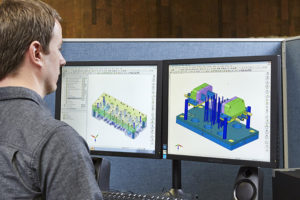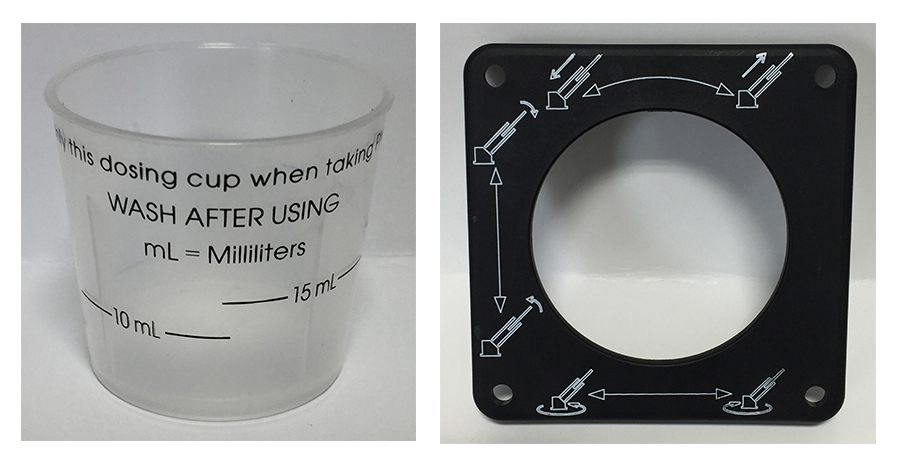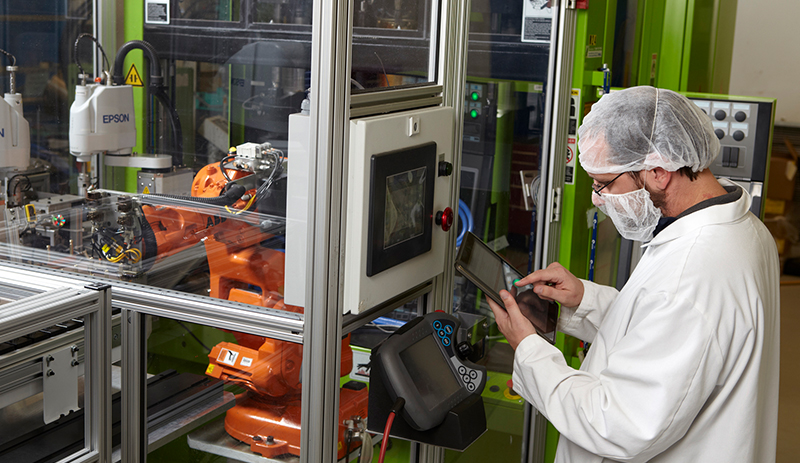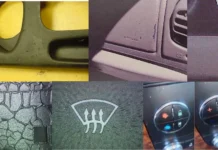by Brittany Willes, editor
Plastics Decorating
These days, the word “smart” has taken on a whole new meaning. With technology advancing by leaps and bounds every year, consumers have their pick of everything from smartphones to smart cars and even smart homes. Of course, this technology also has had an impact on the manufacturing industry, including plastics. As plastics decorating equipment becomes smarter, faster and more reliable, many plastics molders have taken steps to perform more part decoration in-house. This certainly has proven to be beneficial for some molders. However, that doesn’t mean it is the right solution for every situation.

For custom injection molder EVCO Plastics – with locations in DeForest, Wisconsin, and Calhoun, Georgia – adding in-mold labeling (IML) and in-mold decorating (IMD) services made perfect business sense, given the process was designed to be performed during the plastic injection molding cycle. As a result, EVCO has amassed experience with a variety of custom plastic IMD and IML products, which allows the company to develop specialized solutions to meet a customer’s needs without having to extend the overall manufacturing time by reaching out to a third-party decorator. As a result, EVCO has been able to cut down on lost time, as well as the additional expenses, associated with sending products out for decorating.
“Offering our own decorating services in-house allows us to pass along considerable cost savings to our customers,” remarked Project Engineer Paul Wilichowski. “We’re able to make up for a lot of lost time in the manufacturing process when we’re not transferring a run of parts to an outside vendor before finally sending the product on to our customers.”
EVCO offers a multitude of value-added decorating services, including silk screening, pad printing, hot stamping and vacuum metallizing. “With everything kept in-house, we’re able to control the quality standards of our products,” Wilichowski said. Along with in-house engineering and design teams, EVCO operators make use of robotic automation that allows for increased speed and accuracy from concept to delivery.
Having the ability and set-up to decorate in-house has allowed EVCO to expand its current services in an effort to offer customers even more decorating choices. EVCO now offers painting services, including top clear coat painting on molded parts for chemical resistance and UV color coating. “We’re in the process of developing a full UV coating production line, including a surface treatment stage, spray booth with paint robots, flash tunnel and UV curing chamber,” he said.
Clearly, decorating in-house has its advantages. However, like most things, it also has its downsides. For instance, it may not be practical for some smaller companies to invest in print decorating equipment, as it can be expensive and cumbersome. Furthermore, it may not be as cost-effective as it may appear at first glance. When it comes to such services as pad printing, silk screening and others, it’s not enough to simply hit a switch on a machine and hope for the best.
“When it comes to printing on plastic parts, it really comes down to experience and expertise,” said Steven Brock, sales manager for Unique Assembly and Decorating, Inc. “We often say that printing is more art than science, and experience plays a key role when it comes to efficiently producing quality decorated parts.”
With more than 25 years of plastics decorating experience, the Downers Grove, Illinois-based custom decorator has no shortage of experience in turning a molded part into a fully decorated product. “Many of our employees have been with us since the beginning,” Brock continued, “and that kind of experience can’t be replicated with just a few hours of training.”
Molders often have limited experience with the printing side of things and while many may have some experience, it is not their main area of focus. In these instances, the experience level of a custom decorator is going to outweigh the molder’s significantly. With experience comes knowledge, and that’s where the real cost-saving advantages come in.
“Oftentimes, experience eliminates downtime,” Brock said. “There are variables that occur with printing that have to be managed throughout the day. If operators can do that effectively, they can produce more parts per day.” On the other hand, for an inexperienced operator, those same variables can lead to downtime and decreased production.

“If the operator was supposed to get 3,000 parts off a machine in a given day and only managed 2,000, then the cost to produce those 2,000 parts has increased,” he added. “Of course, it’s not as if custom product decorators do not encounter issues that create down time or lower production rates – of course we do. However, with a fixed cost/quoted price for each project, our customers are insulated from any cost increase.”
That’s not to say all molding facilities lack experienced printers. As more molders begin moving at least part of the decorating process in-house, it’s not uncommon to have a team of dedicated plastics decorators on-site. “If a company does have experienced operators that print every day, oftentimes there are only a few of them,” Brock noted. “This can cause serious problems in terms of labor availability. For instance, if there are only four people in a printing department and one person calls in sick, suddenly one quarter of that workforce is gone.”
As Brock noted, for companies that specialize in decorating – and therefore naturally have a larger workforce – a few absences are not as big of a complication. “We have over 40 employees in our company,” he said. “If someone calls in sick, it doesn’t affect us as much because we can move our experienced pool of labor around rather than pull someone from another department to fill that position.” The same is true regarding equipment. Having multiple pieces of the same product decorating equipment for each decorating process allows for continued production with little to no interruption if issues occur with the equipment.
“Using a custom decorator vs. in-house integration allows the molder to focus its investments and personnel on molding and allows the decorator to focus its investments and personnel on the decoration technologies,” stated Mark Kennedy, president of Emerald Corporation, an engineered decorative solutions provider offering full in-house decoration service while also partnering with many injection molders to support their decoration needs. “A clear focus is always best,” he said. Emerald has found this to be especially true when it comes to complex decorative processes.
“We had a project where the customer wanted a decorative pattern that included very complex geometry,” said Kennedy. Capable of providing many overlapping decorative processes – from Class A painting to IMD – the Grand Rapids, Michigan-based decorator is more than familiar with complex designs. These are the types of products for which having that clear focus becomes especially useful.
“We looked at screen printing and IMD and realized that the geometry was too complex for this application,” Kennedy explained. “We also looked at hot stamping, and, again, the geometry was too severe to accommodate that process.”
Eventually, it was determined that a digital print and wrap process would best support the application. Having the ability to work through several solutions, each requiring varying levels of technical expertise and advanced technology, is part of what sets custom decorators apart and gives them an advantage over in-house molder/decorators. As Kennedy noted, however, “There does need to be a good relationship between the molder and decorator, so potential issues can be brought to the attention of the customer in the design and launch phases of a program.”
Another area in which custom decorators have an advantage is when certain obstacles hinder the decorating process. Specializing in silk screen printing for cosmetics, Production Decorating Co., Waterbury, Connecticut, has experienced issues involving chemical testing. “On a few of our recent projects, we have run into challenges overcoming adhesion barriers that require our work to pass strict chemical tests that may come into contact with our finished products,” explained Vice President Brendan Hartnett.
Given that Production Decorating works with materials such as polypropylene, polyethylene, glass-reinforced nylon, PET-G, vinyl and more, “we have a continuous need to overcome this strict adhesion testing,” he said. “As a result, we are always toying with our methods and testing a wide variety of ink brands.”
The company has seen a large increase in specialty cosmetic and private label skin care products in the past few years, mostly as a result of newer brands looking to make a name for themselves. Having the time, personnel and technology to dedicate to specific issues – like adhesion testing – is part of what allows Production Decorating to provide the crisp, professional look these companies are seeking.
Perhaps most important of all, plastics decorating is not just about operating the printing equipment or physically running the parts. A lot of elements go along with printing that have to be considered. “With pad printing, there are films and burning plates and disposal of inks – all of these other aspects of the process that custom decorators already have investment in, that are in their facilities, and that they’re using every day,” said Brock. “It’s not only about the printing itself, it’s about having control of the entire process from the artwork to machine set-up and choosing the right pads, screens, hot stamp dies or plates, to printing the parts and choosing the right pre- and post-cure treatments. It’s not just the printing; it’s the whole process that we excel at.”
The decision whether to decorate plastics parts in-house vs. sending them out to a custom decorator isn’t always straightforward. As companies grow and expand, it makes sense that molders would want to keep more processes in-house as a way of cutting expenses and maintaining control over the product from start to finish. However, all businesses have their areas of expertise, and decorating in-house may not necessarily be the right answer. Depending on the complexity of the product and the skill required to do the job right, sending it out may be the better option.
“Of course, molders who are decorating in-house are typically not walking in blind,” said Brock. “However, they don’t typically have the same level of experience as we do. The reality is, they are oftentimes somewhere in the middle. Working with a quality decorator who has been in the business for a long time, with everything that decorator can bring to the table, a lot of times that’s going to outweigh the perceived cost savings of doing it in-house.”
Plastics Decorating wishes to thank the companies that contributed to this article. For more information regarding their individual decorating services, call Production Decorating Company at 203.574.2975 or visit www.evcoplastics.com, www.uniquepadprinting.com or www.emeraldcorporation.com.





